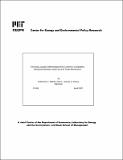Time and location differentiated NOX control in competitive electricity markets using cap-and-trade mechanisms
Author(s)
Martin, Katherine C.; Joskow, Paul L.; Ellerman, A. Denny
Download2007-004.pdf (486.9Kb)
Other Contributors
Massachusetts Institute of Technology. Center for Energy and Environmental Policy Research.
Metadata
Show full item recordAbstract
Due to variations in weather and atmospheric chemistry, the timing and location of nitrogen oxide (NOX) reductions determine their effectiveness in reducing ground-level ozone, which adversely impacts human health. Electric generating plants are the primary stationary sources of NOX in most regions of the United States. In the Eastern U.S. they are subject to a summertime NOX cap and trade program that is not well matched to the time and locational impacts of NOX on ozone formation. We hypothesize that the integration of weather and atmospheric chemistry forecasting, a cap and trade system in which the "exchange rates" for permits can be varied by time and location based on these forecasts, and its application to a competitive wholesale electricity market, can achieve ozone standards more efficiently. To demonstrate the potential for reductions in NOX emissions in the short run, we simulate the magnitude of NOX reductions that can be achieved at various locations and times as a consequence of redispatch of generating units in the "classic" PJM region taking supply-demand balance constraints and network congestion into account. We report simulations using both a zonal model and an optimal power flow model. (cont.) We also estimate the relationship between the level NOX emission prices, competitive market responses to different levels of NOX prices, and the associated reductions in NOx emissions. The estimated maximum potential reductions, which occur at NOX prices of about $125,000/ton, are about 8 tons (20%) hourly in peak electricity demand hours and about 10 tons (50%) in average demand hours. We find that network constraints have little effect on the magnitude of the reductions in NOX emissions.
Date issued
2007Publisher
MIT Center for Energy and Environmental Policy Research
Other identifiers
2007-004
Series/Report no.
MIT-CEEPR (Series) ; 07-004WP.